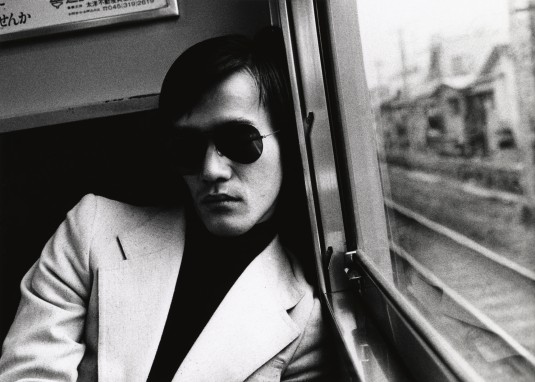
Daido Moriyama
One of the strange elements in Hollywood film, Hollywood naturalism (and in a way, all of Hollywood is naturalistic, even if its fantasy naturalism), and I could easily call this Hollywood corporate real-ism, is that the first thing eliminated from narrative are the frustrating and soul destroying trivialities of daily life. I remember watching several episodes of Ray Donavan (Showtime) this year, which takes place in Los Angeles. And Ray is forever driving all over the city, and seemingly gets from the far reaches of the San Fernando Valley to the airport and then to Hollywood, all in about forty minutes, and is never to be seen sitting in freeway gridlock, sucking down exhaust from the city bus in front of him, nor did he ever seem to have trouble finding a place to park (something, valet parking notwithstanding) something I personally seemed to spend the majority of my waking hours doing while in LA. This is the fantasy of idealized life as depicted by corporate studios. The truth is that everyone is stuck in traffic, even rich residents of Bel Air and Santa Monica. Everyone has trouble parking. The poor have more trouble. The poor have no valet parking. But this extends to real estate as well. It is amazing how large and open are the houses people live in on screen. Even working class folk; waitresses or strippers or mechanics, all of them live in ten room flats with nice views. They rarely have noisey neighbors or water stains on the ceiling or cockroaches or termites. When there are dirty dishes in the sink, it is a fetishized depiction of these dishes, a sign of moral decay or drug addiction or of a slothful nature. Anyone who has raised children knows this isnt slothfulness, it is simply not being able to afford a maid.
The point is that any notion (like that of idiotic film fan cum critic Eileen Jones, or Sadie Doyle) that film is somehow a medium of the people is so astoundingly and just uncooked stupid that I don’t quite know what to say. But onward… the point is that narrative at some point in its history, and my guess would be the mid 1800s, had started to take a turn toward a representation that announced itself as “realistic”, but of course wasn’t (though it might be difficult to decide exactly what this idea means) but it was constructing a set of ideas, tropes, and images that all were given an imprimatur of facticity.
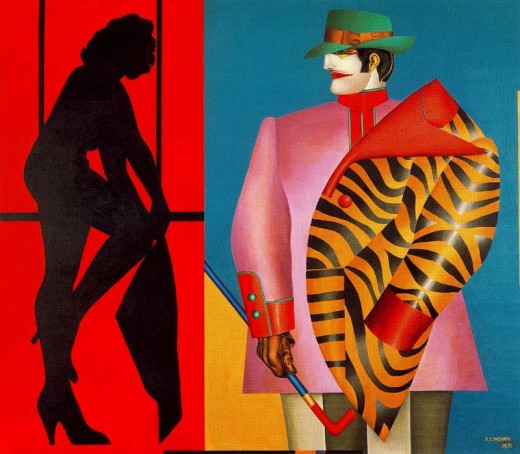
Richard Lindner
It is interesting to examine what factors are in play for establishing the ‘real’. For, the paradox is, of course, that to simply train a film or digital camera on a street corner, or in the middle of the forest, or in a field, and to leave it there for fifteen minutes would result in a fifteen minute surrealist short film.
Which means that daily life, our most basic perception, has been trained to fit perceptual pieces into an already existing sort of mental stencil.
One of the, again, obvious patterns in mainstream culture over-all is the elimination of history. This takes place in outright revisionism (note the Viet Nam war, or Iraq Invasion, or the Civil War, etc) but also in the sense of homogenizing the entire country, as if somehow it was all created in a day by the hand of God. Certain traits are noted: the South is given a place of caraciture, and then Appalachia is seen often in cartoon terms as a bunch of hillbillies. But the real formation of regional collective identity is almost never explored in studio film, and rarely these days in the MFA fiction that passes for serious literature with the NYTimes et al. The long shadow of Puritan values that infests much of the white affluent class, and much of that region of eastern cities and population density is hardly examined. There was an interesting map and short analysis here…
http://www.tufts.edu/alumni/magazine/fall2013/features/up-in-arms.html
There is a good deal of truth in this, though hardly secret knowledge, but one rarely discussed in schools these days. That Scots/Irish immigration that settled in Appalachia was indeed a populace accustomed to war, to fighting off various invaders and occupiers. The history of slavery is written in its most acute form in those states torn between founder cultures (Kansas, Missouri, and Arkansas perhaps). There are contemporary writers who look at the clannish sensibilities of the West, for most of the ones I am thinking of are westerners. For the West doesn’t quite fit this mapping. Mike Davis has written a good deal about the immigration to California, and specifically Los Angeles and Southern California. So has Kem Nunn, and earlier writers like Fante and some of the pulp writers like Chandler and Thompson. For the West remains even now a culturally seperated land of distance and landscapes free of people. Cormac McCarthy, Richard Ford, and James Crumley, all have transcribed something truthful about the land. It is problematic, though, to conflate the Montana and Wyoming rancher with the New Mexico and Arizona and Nevada cowboy culture. The influence of Mexico, of the Spanish language, of the heat and limited grazing land, all make the south west a different kind of Far West. Or the distinct form of life, still remaining, in Quaker founded regions of the east; the sense of town life (and architecture), of manners, of reticent taciturn wariness toward outsiders. The Calvinist Protesent valorizing of work done by hand, equated with integrity and honesty. The bravado of Southern masculinity, which took forms, indeed, as the article suggests, from a landowning non working class of gentlemen bandits. Honor was theatricalized, and machismo resembled something closer to Catholic Mediterranean culture. These sensibilities linger, their residue can be felt, still, in, if nothing else, the kind of propaganda that works in each area. The South has been most disfigured psychologically by their cultural legacies. The machismo is reserved for football games, or a willfull backward looking ignorance.
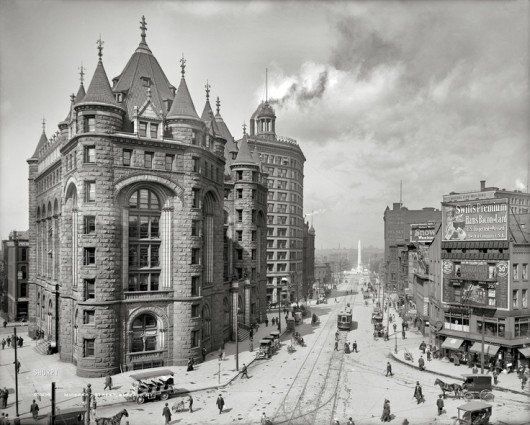
Buffalo, New York 1908
In the 1950s and even into the 60s, regional culture flourished. Local regional radio was one of the delights of driving cross country. In one sense Hollywood is only reflecting a homnogenizing brought on by economic organization of the major industries in each region. But it also created the sense that regional culture was inferior and something to be ashamed of and something to hide. But the discourse that takes place around culture and art now is the result of this shaping of this sense of reality.
The U.S. state has hardly ever contributed a very high percentage of funding to the arts, and when it has it has applied a very stringent form of bookeeping that ensures art is seen as financially risky and inherently flawed from a business standpoint. As Raymond Williams said:
“We have seen since the sixties (in the U.K.) in case after case, where commerical standards and priorities have been steadily reimposed. Moreover the social relations and ideas of the dominant economy continually replenish crude ideas of isolated profit and loss, from which resentment against the selected areas both grows and is nourished.”
This is true in the U.S., too, of course. Arts funding, the NEA and various arts councils have been scrutinzed in ways other commercial areas are not. The hidden subsidizing of big corporations is never brought up, and only the bad business of art is discussed. And really we are only talking about the so called “prestige” arts. All this really points up is that contemporary Western society has an increasingly suspicious and incredulous attitude toward culture. And it is at this point that a discussion of this turn toward a manufactured “real” intersects with arts education. From the beginning the teaching of arts indicates to students the default setting of culture as non-essential. The idea of the arts, of any kind, playing a role in forming values relating to politics, to human relationships, to social dynamics, is ignored. I am sure a lot of people in the arts have had the experience of trying to discuss modern art with people outside the arts, perhaps totally, and finding the basic mind set is one of innate hostility, but also of a basic point of view that starts with ideas of realism. If it is painting, the realistic is seen as the goal and any expressionistic touches are allowed as a sort of ornamentation, much as one would carve a border on a chest of drawers one had made. Realism in narrative means, usually, is it probable. Can the viewer accept this “might” have happened. Its almost a statistical model for granting value. Cutting across these bedrock positions is the idea of popularity. If the artwork makes money, then it can’t be all bad. The artist is at least canny and clever for having somehow extracted a profit out of what he or she has done. All young writers know the question “have you been published”? And this is the model for most approaches to culture. Does the artwork have a role in the economy?
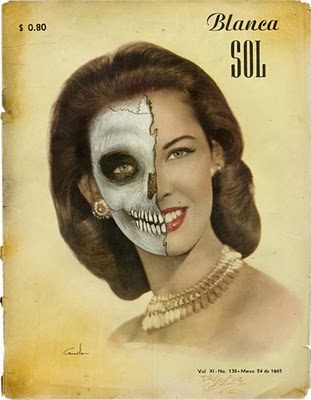
Dr. Lakra
Now, to bring this back to regional differences and regional culture, its easy enough to see that mass corporate created culture, a culture that erases history and manufactures an almost completely homogenized product (thereby appealing to the broadest possible base) has helped reinforce the idea of regional folk or traditional culture as inferior. This was always the standard or touchstone for academia as well. The evolution of a regressive democratizing (populist) of art went hand in hand with the goal of correcting elitist white partriarchy in all social relations. Diversity, and multiculturalism was an obvious corrective but one that was seized and co-opted almost before it began. The co-opting in the arts was in service of political racism and policies of control from the right. Multiculturalism in Europe, for example, was used by far right parties (and a lot of liberal ones, too) to impose draconian immigration policies targeting Muslim immigrants in particular, but really, anyone not white. Women were particularly discriminated against, in relation to religious attire and new definitions for gaining citizenship or even residence. This is not the topic of this positing, but I only wanted to point out that in the arts the same hierarchies were in place, but given cover by the implementation of this ersatz populism, and against the unchanging backdrop of this created Western “realism”.
The attacks on multiculturalism, starting as far back as Thatcher, who conflated, strategically the terms ‘culture’ and ‘race’, while at the same time invoking images of infection, of pestilential waves of dark skinned ‘others’ who would “swamp British society”. Immigrants were described as ‘self segregating’, and hostile to western values. What is important, for this posting, is the ways in which multiculturalism affected the ever dwindling arts funding in the U.S. As money dried up, the remaining pittance was increasingly linked to institutions, and usually under academic authority. Prestige arts (ballet, opera, symphony orchestras, etc) were given the majority funding. Non traditional arts, and independent community programs, small touring companies, etc, were ignored. Those who did find their way in were the most bland, the most obedient, and the most compliant. It speaks to just how far the idea of an avant garde has receeded in popular consciousness. And it is here, exactly, where arts education enters the discussion, again. The rewarding of bland inofensive community arts programs only further propped up the status quo. Multiculturalism was granted discussion space, as long as it didnt actually threaten the white paradigm, or question the very idea of what culture was supposed to be doing. The selection process was grounded in assimilation by-cosmetic-difference. The actual struggles of forced migration for millions, the repressive legislation against ‘religious garments’, or health practices, or just poverty, is selectively addressed at best. And the cause of the forced migration, the cause of “failed states”, the cause of war and famine, were simply taboo as a topic. The problem is, as Thatcher conflated race and culture, the new use of “culture” as a political marker was a safe substitute for race because PR experts recognized race could no longer be addressed as ‘inferior’ or ‘superior’….but culture on the other hand, was still safe to place in a hierarchal setting. And this meant that addressing arts funding in the U.S. and arts education, was a mine field in which vocabulary became a highly charged arena. Bad art, if minority art, was simply playing into the arguments of the fascist right. The state had no problem giving a few crumbs to “other” cultures, as long as they were controlled politically. In fact, the blander the art, the better. Paternalism remains the default setting for institutional funders. When anyone in the West uses the word ‘culture’, they really mean white privilege.
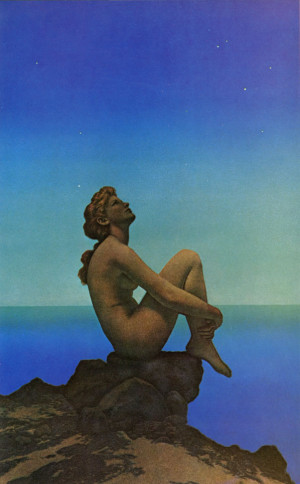
Maxfield Parrish
A side note here, because one of the problems with this discussion today is the crudely simplistic critique of Zizek, with which one is sadly going to be confused with, and which gained so much traction, and basically equated any kind of tolerance with racism. Multiculturalists were just racists. In fact, it is Zizek’s argument that is racist, and a projection of white privilege, by way of suggesting racism is simply a given. And to deny intolerance is somehow just another form of intolerance. But this sort of thing is typical of Zizek, but it has become part of a larger tactic of targeting generalizations to put in use for justifiying western capitalist domination. The actuality is that colonial perspectives remain intact, and are part of the smothering of art and culture, because appropriation of ‘other’s’ narratives and image and style was the starting point.
The idea of artists as oppositional or socially adversarial is almost forgotten today by young artists. Obviously careerism is a big part of this, the equating of success with financial reward, and yes, with popularity. But it goes beyond this to the level of basic cultural education. In the U.S. there remains a great hostility to art per se. Art history has been dropped in almost all high schools in the U.S. and the few art classes that remain are taught by instructors who themselves have had to compromise whatever ideals they had to survive the growing corporatism of public education. Today there is a generation that can remember no further back than Jay Z. probably. Those who do, those few strange driven individuals are faced with almost impossible obstacles to even finding the barest sort of living income from their art.
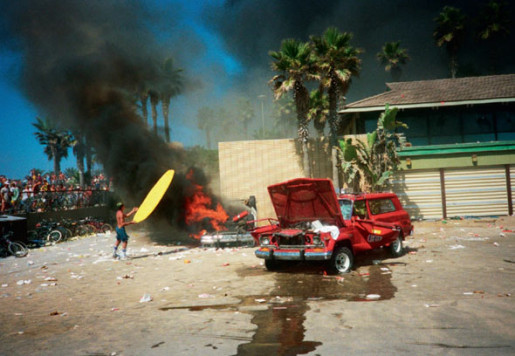
Nick Waplington
There is also the problem of education and its linkage to institutional and academic values about art. There are exceptions, as there always are, but the overriding reality of liberal white education on the arts is that one not be too difficult. Art that is disruptive is not going to be funded. And the employment in the culture sphere of terms like multiculturalism has been in the service of teaching a very unsophisticated aesthetic, and a general devaluing of art. It has eliminated the revolutionary dimension of aesthetics.
Part of the co-opting of multiculturalism has been to encourage a regressive nationalism. As if the underclass forced into migration, shared something of value, more value, with their own ruling class than with workers in their new country. Its always about class. The discussion of intersectional threads…gender, queer rights, etc…is worth talking about exactly at this point, but for the purposes of this posting, I want to return to the role of popularity in western, U.S. society today. And to the way in which the ‘real’ is manufactured. The shift toward elimination of radical voices in media reached effective success around 2000. What you get on mainstream and even most of what would be seen as alternative press (and there is very little) is a totally constructed picture of the world. News shows in a sense are the worst. If “experts” are called in for interviews, they are either Pentagon officials or ex military, or they are corporate business leaders. Accreditation means validity, and only the most conformist and uncritical voices get accreditation. How many University professors can you name who are seriously anti capitalist? I can think of a dozen. There might be a hundred … I am sure if you dug you could come up with a hundred, and who knows, maybe two hundred. For all I know there are five thousand, or ten, but most don’t teach what they believe, even if that many believe it. That is out of 1,496,810 post secondary school teachers in the US as of 2012. We could break this down to tenure track positions, and adjuncts, etc. But the point is, there is remarkable specialization, and rarely do professors speak on matters outside their specialty, because they are not asked to, and because usually they dont know anything outside of their specialty. So, most dont evince much curiosity. Media ask for conformity. Media has a story they are selling. They make sure it gets sold effectively. And the backdrop to that story, the landscape in which these manufactured stories take place, is largely constructed by the culture industry.
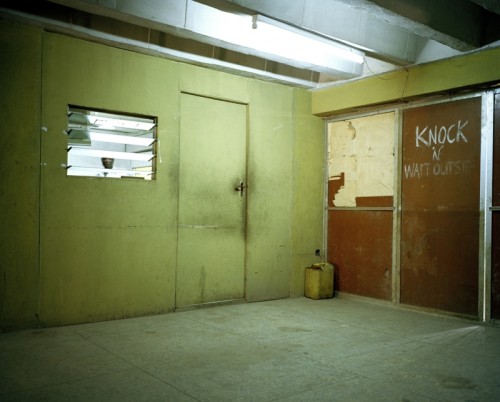
Paul Seawright
Most Hollywood product indicates which of about three different style codes are going to be at work. Another way of saying ‘genre’, but it’s not quite that. The prestige liberal film appeals to educated white (usually male) class and is built around themes of accountability in government, or restoring some grand old golden era of integrity and hard work. What lies behind this nostalgia is the dream of a segregated white world. It is the updated version of Norman Rockwell. Then there is the action movie reality. These include Marvell and DC comics, as well as various sci fi franchises (and most fantasy, too). From The Terminator to Star Wars, to War of the Worlds and even most Zombie films, is a white male heroism predicated on military values, on violence as a process of cleansing and regeneration, and most are deeply misogynist as well. But the primary setting is really not that greatly different from the Robert Redford white liberal male version of the first. And then there are the various comedy versions, from Adam Sandler to Seth Rogan, and tons in between, this is the affulent white class reliving its adolescence. A highly privileged adolescence. One finds the arch prestige version of this in Rachel Kushner for example, in the lit world, and you see it in countless TV sit coms as well. The backdrop is again white. It is a fantasy suburbia, that is modeled on Bel Air or Beverly Hills and not Lakewood California or Simi Valley, or any of thousands of other cultural wastelands and pockets of depression across the U.S. In fact, when the idea of suburbia as a conformist prison is actually given expression, it is almost always mediated by other factors … such as The Truman Show, in which the burbs are all a huge TV show set. There are small domesticated echos of Phillip K. Dick in this film, but they are set against a strangely tolerant vision of NSA like surveillance. YOU are being watched. But you might learn to like it. One of the only films I can think of that captured the malaise of suburbia and planned communities was the 1979 Over the Edge, directed by Jonathan Kaplan, and Matt Dillon’s first film. It is interesting to note that criticism of suburbia and small town life is more acute in the U.K. There is an artistic narrative sense of the poisons and restrictions of small towns, and the intolerance. The final most glaring genre for this discussion is the ‘political thriller’. I cannot think of a single example in which the hero is not military trained. Backstory for Hollywood means authenticity is bestowed by the military, even if some later dissilluionment develops. Masculinity is directly proportional with military training. The ultimate version of this, in a way, is the Bourne franchise. But all of them owe a certain debt to the James Bond worldview. Ian Fleming, inveterate cold warrior and arch reactionary, and son of a hugely wealthy banking family, the Fleming world was neo-colonialist, imperialist, and disdainful of the ‘natives’. It is anti communist, and utterly accepting of the natural division of the classes. Hollywood and its corporate financers see the world much the same way. An action film on behalf of the Sandanistas, fighting against the Contras (as I once suggested to Chuck Norris…and no, I didn’t get that job) is unthinkable, or a grass roots insurgency against CIA funded death squads somewhere in the Southern hemisphere is not possible. And because it is not possible, for big money backers, the general population has never processed a narrative in which such things take place. So, if one suggests a film about Che, what you get is a defensivness in the most basic storytelling architecture. A film about South African apartheid is alright, and has been made, but always this drama is laid out as an anomoly, and one in which the resolution promises an integration into the great white capitalist world.
The point is that in these military infused landscapes, and in a nostalgic fantasy childhood suburbia, the creation of perspective is largely focused on white problems, and white affulent problems. If there are black characters, they are there in a strange dislocated way portraying white men. Recent films have allowed a number of black Presidents, and the odd reflection of reality here, in which Obama has emerged as the most ruthless white overlord of the poor possible. But of course the President is, to a large degree, a theatrical position anyway. As someone said recently, Obama thinks politics is based on better propaganda. The global south is invisible in mainstream media. To humanize the global south simply never takes place. I can’t think of a film. Now, there are small independent films on the topic, but almost always the form is colonialist. The structure of the narrative is familiar and the larger structure of how these stories are granted acces, all contains messages. In the same way individual artists can apply for and recieve grants, thereby marking them out as needy, so the poor of the global south are allowed visibility, thereby marking them out as only capable of stories of poverty and suffering. One can only see the poor and the regions of poverty, in narratives of failure and pain. The message is, the natural role for Central Americans is maid or gardner, the natural role for Arabs is terrorist. The natural role for inner city kids is gang banger, drug dealer, or heroic exception saved by and assimilated into white prosperity.
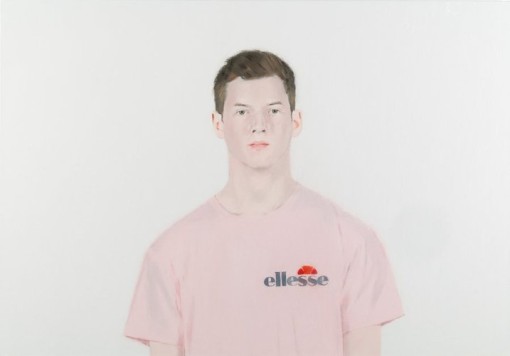
Allesandro Raho
People today learn what the world looks like through film and TV. Both Hollywood fictional drama and entertainment, and through news programs. Each specific film is then an illustration of an aspect of this society. And period films are usually illustrations of contemporary values applied to the past. The public today has an ever harder time recognizing anachronisms. The world of today is the only world. And today is a corporate creation. The protagonist of most film and TV today is amazingly mobile. Train or plane tickets are never unaffordable. Parking places are easy to find. Traffic jams don’t exist. Lines also seem not to exist. And violence is deserved, and applied without repurcussion. The number of shooting deaths, of mass police and criminal shoot outs is astounding, and yet rarely are their problems afterwards. Military operations rarely cause collateral damage. The body parts of children are certainly not shown. Dead mothers and dead grandfathers or any innocent civilian are rarely seen, unless caused a terrorist bomb, and even then it is usually just talked about. I was amazed the other day when in an episode of Braquo, the French made police show when a character, a villain, turned out to be a former KLA killer who terrorized Serb villages. First time EVER I can remember that occuring. So people learn Castro is a tyrant, a drug trafficker and funder of terrorism. They learn (usually) that Serbs are genocidal maniacs and Israel is tolerant progress loving democracy. They learn black people were living alongside whites in pre civil war America, and hardly ever raped or lynched. The rewriting of the past to fit the white liberal conceits of today is an increasing trend. The portrairt of contemporary urban life is happy; jobs rarely cause stress, bosses don’t sexually harass their workers, and if they do, punishment is easily realized. Evil corporate tycoons are shown to exert power, and cause harm, but are brought to justice, and even if not, this is seen as something of an aberation. Generally capitalism is shown to work.
And another aspect of this is that a public, and even those studying in Universities, are discouraged from examining their own psychic formation. They are never asked to examine how they came to believe something. Everything having to do with values is laid off on nature. This is just the way it is. The structuralist critique, and post structuralist, has been put in service of something quite different I think. It has been subsumed. This is partly the intense focus of specialized studies. The non academic population, the non specialist, is discouraged from thinking about anything beyond entertainment. Distraction. The ‘real’ is granted authority by virtue of an instrumental logic that valorizes anything of a statistical nature, and connected to science. Just start a sentence with “studies show…” and submission follows. There are so many simply false studies, as an additional factor, that the end result is an atrophy of curiosity. And this is by far more pronounced in the United States. People do not think of applying theory of any kind to their own specific daily problems. And in the manufactured ‘real’ this has been the message; dont question authority. And authority is institutional, and that includes education and research.

Walt Disney & Wernher Von Braun
What I am getting at (slowly I admit) is that the devolving sense of aesthetics is a huge factor in an increasingly incoherent world view for the western populace. The loss of community based traditional knowledge and culture has left people with only the culture industry and corporatized public education. Learning to engage with narrative as if it mattered to one’s daily struggles is stalled at the start. There are great political implications in learning the difference between form and content. In learning what alegory means. The mind numbing repetitive frustrations of daily life, the pressures and unfairness, the fear and sense of dread about the future, and your children’s future, leaves little time for reflection. And the constant drum beat from media about the frivilous and elitist nature of art has meant an ever greater turning away from cultural examination. People are stigmatized and shamed for being ‘conspiracy theorists’ if they question the official version of news. They are bullied about an interest in art; which is feminine and for weirdos. Marketing constantly beats home the theme of anti intellectualism. The only valid studies have to do with scientific research or physical strength. Power is equated with moral authority. The “real” is not real. It is false. The endless reality shows are another example of the unreality of this ‘real’. The acting out of various pathologies from within these artifical theatres of shaming bears scant relationship to any basic primal experience of life. The public is ridiculed by the affluent white 20%. Those who do not go into secondary education are bullied for any interest in cultural affairs. And especially for an interest in art. And without an avant garde, without radical voices, the world of art is increasingly neutered and obedient. Arts Councils are there to rid the artworld of art. They are there to promote laughably bad art as only a sort of granted therapy for the poor, while valorizing prestige culture as a realm best left to rich white folk. When I heard the NEA was being essentially dismantled, I thought, well, good. They are collaboraters in the false creation and sustaining of the ‘real’. Where once idependent vision was at least accessable to those curious enough to seek it out, the situation today where a public with ever greater financial insecurity, and which knows it is being monitored, the access is severely restricted.
“What is social in art is its immanent movement against society, not in its manifest opinions.”
Adorno
The teaching of art today, when it even occurs, emphasizes a social function. A purpose. A therapeutic role. The lack of purpose is part of any radical vision. Narrative is asked to provide resolution, and instruction. And even for the left, the message is still what matters most. The numbness of daily reality can only be broached by that which is disenchanting, that which negates the false. And that negation means stepping outside the ‘real’, though in a totally mediated world, nothing is outside. The acceptance of novelty and a pseudo difference, of innovation in art, only hides the exchange value as the guiding principle. Learn to accept the fetish quality of art when it is at work in negating the prevailing ‘real’. If you aren’t denying the ‘real’, you are endorsing it.
Popularity is the expression of financial models of capitalist success. Of course Jeff Koons is tolerated as a millionaire court jester, for he is reproducing the lie, while making art itself something of a joke. The left’s fear of abstraction is another indicator of default dependence on the ‘real’, on instrumental logic.
“To this extent, each artwork could be charged with false consciousness and chalked up to ideology. In formal terms, independent of what they say, they are ideology in that arpriori they posit something spiritual as being independent from the conditions of its material conditions and therefore as being instrinsically superior and beyond the primordial guilt of the seperation of physical and spiritual labor.”
Adorno
In an era of technological domination of attention, the possibility for autonomous form is ever harder to find. The imposition of exchange value distorts perception. It deforms the mimetic capacity at its most fundamental level. For the inescapable role of individual mental formation is in conflict with the corporate kitsch ‘real’, that which is sanctioned as true because of its success and popularity and it’s connection to science and statistical proofs. Aesthetic imagination can only find space to exist by learning to reject (and first by learning to recognize) the social domination of this reflex reality. And if one examines more closely even the camera angles and editing of mainstream Hollywood film and TV product, the repetitions of certain shots within certain stories has created a host of expectations and anticipation in the audience. This then gets carried over to daily life. People now walk to their cars and carry with them an irrational fear of mugging or zombie attacks, even if not conscious. That someone is always directly over your shoulder suggests the camera is now an entity in the world that people fear. The attacker, the terrorist, the mugger, the drug dealer, is right over my right shoulder. That the police now are given impunity to murder is both the overt racism of the system, and also the semi-conscious expectation of crime as an always present companion. Cops have, probably, the most shrunken imaginations of any sub group in the society.

Maurice de Vlaminick
The coming Trans Pacific Partnership has been held in secret, essentially. It is a corporate protection act, anti democratic, and stunningly in line with a coming global police state. http://americablog.com/2013/11/bill-moyers-trans-pacific-partnership-free-trade-agreement-death-democracy.html?fb_action_ids=226896530804183&fb_action_types=og.likes&fb_source=other_multiline&action_object_map=%7B%22226896530804183%22%3A187101198145784%7D&action_type_map=%7B%22226896530804183%22%3A%22og.likes%22%7D&action_ref_map=%5B%5D
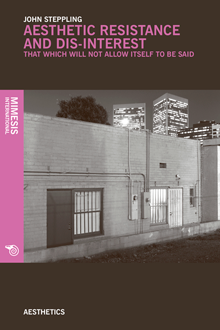
I’m curious why you begin with Thatcher and not Reagan as instrumental in the xenophobic fightback against the ‘pestilential hordes’ given your background? Enoch Powell’s race hatred is what Thatcher was tapping into. Just as Powell tapped into Keith Jones, in the period before. For me, as a poc living out the last years of Thatcherism, the assault on the family is the most striking thing that she will be remembered for. People who grew up during Thatcherism saw the National Front routed while single mothers became an easier target for the likes of the Sun. Anti-racism was in the ascendancy during that time. People can tell you about agitprops outside South Africa house with the demands to free Mandela and the tories wrong-footing public opinion, time and time again. Eventually culminating in SA House being set fire to during the Poll Tax riots.
That aside, I’m also thinking about realism right now. Having just read the script for The Bicycle Thieves, for me this is an absolutely perfect moment in cinema and before the term multiculturalism was coined. The script comes with a foreword by a Simon Hartog who goes to great lengths to rubbish the film …for obvious reasons. The script, I find, is a very old copy released from a UK university library which I bought for 0.2p online recently and which was never opened in all these years!
Hartog’s complaint is that De Sica is trying to ‘condition a protest’ as if this was a bad motivation for making the film! The plot revolves around a man trying to find his stolen bicycle. It’s an examination of solidarity and ethics. A man is compelled to abandon his ethics for the job, on which his family relies. All the institutions of the day – the police, the church, the unions – fail this man in his search to recover his stolen bicycle. When finally broken by his search, he decides to steal a bicycle, he is caught, alone, except for the son who witnesses his father being chased down the street. In that moment, his son, who has accompanied him on this search is also broken. But this moment of break-down has been treated by the critics as the son’s initiation into manhood. The son becoming a father. That interpretation is telling. Especially, as looking at the way the family has been portrayed when the protagonist is the father. I’m thinking Shameless and a whole load of UK television dramas that portray the father as feckless. Not fit for purpose.
For de Hartog this is a ‘primitive prise de conscience’. That final scene shows the bicycle thief being granted solidarity by people he has no kin relationship with who at one moment were prepared to throw him to the dogs. Anyway, it’s a tear-jerking ending but one I recognise as ‘real’. It’s open ended too so that there is no resolution. For just this moment.he has been saved… now what will happen, when he gets home?
Zavattini, who wrote the script, remarked that this was an initial protest and that the job of cinema was to go further, say more but for me this film says everything. I can’t imagine yet how one can go further without a Renoir-like expository treatment in The River [worst film ever… ducks].
I’m also watching a lot of Poverty Porn… the kind of cinema coming out of Africa and India that followed Slum Dog Millionaire and strives towards resolutions in which the poor kid makes good in the end or becomes a war lord. Bicycle Thieves avoided these endings.
@uncle:
I mention thatcher because this was about this idea of “multiculturalism” which i think she contributed a specific vocabulary for. Certainly Reagan attacked the poor even more savagely than Thatcher , but Reagan had a different set of circumstances anjd a history as an actor. But in terms of cultural affairs and the funding for culture and the invention of a grammar for race, I think Thatcher made that one crucial substitution, race and culture…..which was so significant….while Reagan didnt in cultural terms . But his image of welfare mothers, laying around living off govt checks with six children became the base of the retrenched racism of the 80s. I just think the idea of multiculturalism started in europe. But you can argue that I suppose.
As for DeSica………well, this is a favorite film of leftist film critics. I think its a good film. I dont think its a great film, but I dont think much italian neo realism was in the end great. But mostly because its melodrama. I dont dislike it, but I think for example Pasolini is a far greater filmmaker than DeSica. But i do quite admire Rossellini’s early work. Rome Open City is a masterpiece, but its one of those masterpieces that feels a bit tedious these days. That said, I think those directors were all quite important…Visconti, Rossellini, DeSica and even the minor guys; but there is this question of ‘realism’ attached and there are two sort branches of this discussion,. One is the post war and post facism climate of the country at that time. Germany Year Zero is actually I think the best film of that whole period…and its a good representive because it captures this quality of pragmatism and even cynicism of a population. Its moving, without question. But in terms of cinematic form, the films feel leaden to me today, and they did when i first saw them forty years ago. There is this novelistic quality, and a melodramtic short hand at work. A quasi documentary quality. The almost verite camera….but see, Bazin thought italian neo realism wasnt really realism because it was about the experience of life, not the appearance (i paraphrase). Most people dont see those films as anything other than realism. Rossellini talked about the moral camera. The moral camera subsumed technical issues. Well, yeah, ok…..I guess. The problem is, thats not what I see when Iwatch those films today. Yes the narrative is full of digressions, and can be pretty elliptical, but in the end, there is this baseline about time and space…documenting something, and even if Rossellini wants to talk about awareness over perspective, this doesnt change anything. I personally loved his late work….Louis the sun king, and those TV histories he made…..where things had become far more artificial. So….when i see the De Sica today, I feel it sort of falls down a bit under the weight of this melodramatic form. But i agree it is a smart and moving script. It is. Its just not, for me, anything as deep as what later, Pasolini did. And as for poverty porn. Well, yeah. Slumdog is an odious exercise is colonial appropriation. White folks love that.